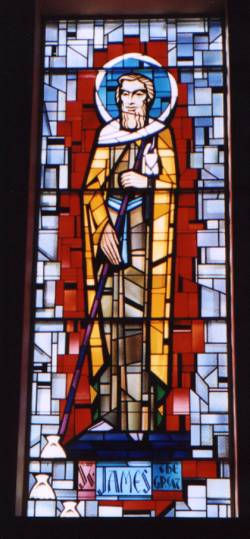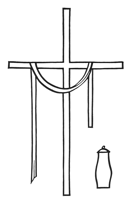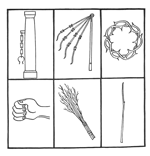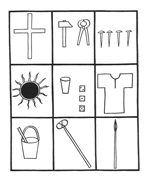
Part One: The Apostles’ Creed
4.
“
Suffered Under Pontius Pilate, was Crucified, Died, and was Buried”
 We get some idea of the importance of this article of the
Creed from St. Paul’s statement to the Corinthians, that “I judged not myself
to know anything among you, but Jesus Christ, and Him crucified” (I Corinthians
2:2).
We get some idea of the importance of this article of the
Creed from St. Paul’s statement to the Corinthians, that “I judged not myself
to know anything among you, but Jesus Christ, and Him crucified” (I Corinthians
2:2).
Christ’s Passion, death, and burial should be deeply understood. They are the crowning proof of God’s love for us. They are also the most powerful motive for our loving God, and the model of how we are to love Him in return. There are four verbs in this article, and each deserves a volume of explanation. Jesus Christ suffered; He was crucified, died, and was buried. The narrative of Christ’s Passion in the gospels amounts to a total of four hundred verses, excluding Christ’s five-chapter discourse at the Last Supper, given by St. John. The sheer amount of revealed data indicates the importance of the Redeemer’s sufferings, in the mind of the Holy Spirit who inspired the Sacred Scriptures.
Sufferings of ChristSuffering is the experience of pain. It is the bodily and spiritual experience of what we naturally dislike, the conscious endurance of what we find disagreeable, and the mental awareness that we are undergoing what is against our spontaneous human desires. Immediately we see that we can react in two opposite ways to a painful experience. We can either resist, or we can patiently endure what we experience. In fact, patience is the willing endurance of pain. Christ’s sufferings, we know, were borne with patience. This deserves some explanation and is most clearly seen in the hours of His bloody agony in the Garden of Olives. He naturally shrank from pain, no less than we do. After all, He was truly human. This becomes evident from the prayer He addressed to His heavenly Father when He begged. “If you are willing, take this chalice from me.” But having said this, He promptly added, “Nevertheless let your will be done, not mine.” Thereupon, “an angel appeared to Him, coming from heaven, to give Him strength” (Luke 22:42-43). The first part of Christ’s prayer was the expression of His human feelings, the instinctive and involuntary dread of pain. The second part was the manifestation of His patience, the voluntary acceptance of what His natural feelings dreaded. And the appearance of the angel came after He had spoken His resignation to the will of the Father. The angel, be it noted, did not remove the pain but provided Him with additional strength for His will to bear the suffering with patient resignation to the will of God.
In the soul was the pain of rejection and humiliation, of opposition by His enemies and abandonment by His friends, of a sense of failure at seeing so many clamoring for His death, who only a few days before were praising Him to the skies, of the cruel ingratitude from the very people for whom He had done so much, even to working numerous miracles in their favor. To all of this present suffering that Jesus experienced during the hours of His Passion in Palestine, we must add the pain He endured by anticipating the future. Even as man, He foresaw that multitudes in the centuries to come would ignore the sufferings and reject His grace. Yet He bore all of this pain patiently with His human will, while all His instinctive human feelings recoiled at the very thought of so much agony. The Crucifixion. Among the Jews, no form of death was considered more disgraceful than crucifixion. And among the pagan Romans, no form of execution was considered more painful than to be crucified.
We say that Christ endured the Cross, and the expression is correct enough. But it does not fully express what actually occurred. It was not only the passive, even the patient endurance of the inevitable: It was the conscious and deliberate choice of what Jesus need not have suffered at all. Yet He decided with His mind and freely chose with His will what He knew was the worst form of pain. Death of Christ. It may seem strange to profess that Christ was not only crucified, but that He died. What are we saying? We are saying that Jesus redeemed the world from sin by enduring the consequences of sin, which are death. The sin of our first parents deprived them and their descendants of the supernatural life they possessed before they fell. Already in Genesis, they were told by God that in whatever day they disobeyed Him they would die. Eve was reassured by the devil that God was not telling the truth. She prevailed upon Adam to join her in resisting the divine will. The inevitable happened. Bodily death entered the world through the devil’s instigation, as the visible result of the spiritual death that took place with the first grave offense committed against God by human beings. When Christ decided to redeem us, He chose the very form of penalty that, as God, He had laid on a sinful human race. His bodily death on Calvary, therefore, was not coincidental: It was deeply providential. It was expiation by God become man by suffering for our sake the price of our redemption. What occurred when Jesus died? It was the separation of His human soul from His human body. There was no question of Christ’s humanity being for a moment separated from the Second Person of the Trinity. Although His body and soul were separated from each other, both remained united with His Divinity. Thus every drop of blood that Jesus shed on Calvary was literally the blood of the living God. Burial in the Grave. The burial of Christ’s body was consistent with His predestined plan of man’s redemption, and all four evangelists tell the story of where and how Jesus was buried. The initiative for burying the Savior came from Joseph of Arimathea, a councillor of high rank and a disciple of Jesus. He went boldly to Pilate to ask for the body. Pilate wondered if Jesus was already dead. So he sent for the centurion who witnessed the crucifixion. “And when he learned from the centurion that He was, he granted the body to Joseph” (Mark 15:45). Joseph then took the body down from the Cross. He wrapped it in a clean linen cloth and laid it in his own new tomb that had been hewn out of the rock. Then he rolled a large stone across the entrance of the tomb. With Joseph at the burial was also Nicodemus, who had first come to Jesus by night for fear of the Jews. Watching the burial were Mary, the mother of Jesus, and Mary Magdalene. The detailed account of the burial verified that Christ was truly dead: that He was completely wrapped up in a shroud; that His body was placed in a stone tomb; and that the tomb was sealed with a huge rock. We are further told that the day after the burial, the chief priests and the Pharisees went in a body to Pilate. They told the procurator: “That deceiver said, while he was yet alive, ‘After three days I will rise again.’ Give orders, therefore, that the sepulchre be guarded until the third day, or else his disciples may come and steal him away, and say to the people, ‘He has risen from the dead’; and the last imposture will be worse than the first.” Pilate said to them, “You have a guard; go, guard it as well as you know how.” So they went and made the sepulchre secure, sealing the stone and setting the guard (Matthew 27:63-66). All of these details are priceless evidence that the resurrection of Christ on Easter Sunday was an historical fact. 
Copyright © 2002 Inter Mirifica
Pocket Catholic Catechism |
 So we might go through the whole account of the sufferings
of Jesus, from the agony in Gethsemane to the crucifixion on Calvary. Christ’s
sufferings were always both in the body and in the soul. In the body was the
pain caused by emotional reaction to being scourged and crowned with thorns,
being forced to carry a heavy cross and then nailed to the Cross and allowed to
die by having the body totally drained of its blood.
So we might go through the whole account of the sufferings
of Jesus, from the agony in Gethsemane to the crucifixion on Calvary. Christ’s
sufferings were always both in the body and in the soul. In the body was the
pain caused by emotional reaction to being scourged and crowned with thorns,
being forced to carry a heavy cross and then nailed to the Cross and allowed to
die by having the body totally drained of its blood. What needs to be stressed is that Christ chose to be
crucified. Both on the level of humiliation and of agonizing pain, He chose to
undergo crucifixion because he wanted to show His love for us in the extreme.
It cannot be emphasized too much that when revelation tells us Jesus chose the
Cross, this is no mere symbolism or figure of speech. The Savior had every
option possible – either to redeem us without suffering, or to redeem by
experiencing pain; again, either to suffer or suffer to the limit of human
ingenuity to inflict emotional and physical pain. He chose the outer limits of
agony, and did so with perfect freedom.
What needs to be stressed is that Christ chose to be
crucified. Both on the level of humiliation and of agonizing pain, He chose to
undergo crucifixion because he wanted to show His love for us in the extreme.
It cannot be emphasized too much that when revelation tells us Jesus chose the
Cross, this is no mere symbolism or figure of speech. The Savior had every
option possible – either to redeem us without suffering, or to redeem by
experiencing pain; again, either to suffer or suffer to the limit of human
ingenuity to inflict emotional and physical pain. He chose the outer limits of
agony, and did so with perfect freedom.